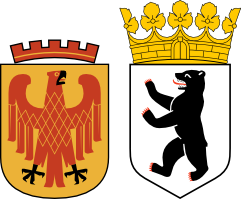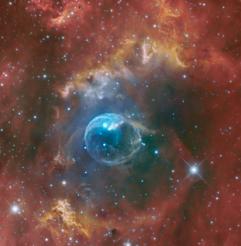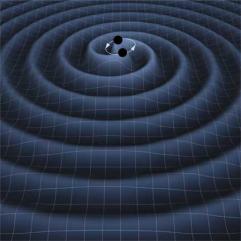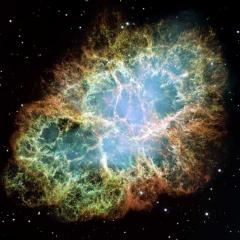Colloquium
5. Potsdam-Berlin-Kolloquium

- Wappen von Potsdam und Berlin
Hiermit möchten wir Sie zum fünften Potsdam-Berlin-Kolloquium einladen, das am Freitag, 30. Oktober 2015 ab 14 Uhr an der Technischen Universität Berlin stattfinden wird. Die fünf Vorträge dienen dem Ziel, den wissenschaftlichen Austausch zwischen den verschiedenen Instituten im Raum Berlin-Potsdam zu fördern.
Inhaltlich wird dabei ein Bogen geschlagen von terrestrischen Planeten und der Sonne über massereiche Sterne und Neutronensterne bis zu Supernovae und ihren Spuren auf der Erde. Wir freuen uns auf eine Vielzahl von Teilnehmern und möchten insbesondere Studierende ermutigen, zu uns zu stoßen!
Modelling the stellar winds from hot and cool stars

- NGC 7635 (The Bubble Nebula) - A strong stellar wind and intense radiation from a star has blasted out the structure of glowing gas against denser material in a surrounding molecular cloud.

- © Bernard Michaud
Dr. Jonathan Mackey
(Argelander-Institut für Astronomie, Universität Bonn)
Dienstag/Tuesday, 2014-12-09 14:00 c.t., EW 229
Eugene-Paul-Wigner Gebäude, Hardenbergstr. 36, 10623 Berlin
Zusammenfassung/Abstract:
Mass loss from massive stars is very important for determining their evolution and death, but their wind properties can be difficult to measure and are often very uncertain.
Main sequence massive stars have fast and highly ionized winds, driving bubbles in their surroundings that have proven surprisingly difficult to detect. We have run simulations showing that wind bubbles are typically very asymmetric and do not fill their HII regions.
Coalescence of intermediate-mass black holes: Implications for GW Astronomy

- An artist's representation of the burst of gravitational waves resulting from the collision of a colliding pair of black holes.

- © LIGO Scientific Collaboration (LSC) / NASA
Dr. Pau Amaro-Seoane
(AEI Potsdam-Golm)
Freitag/Friday, 2014-12-05, 14:00 c.t., EW 561
Eugene-Paul-Wigner Gebäude, Hardenbergstr. 36, 10623 Berlin
Zusammenfassung/Abstract:
Observations suggest that star clusters often form in binaries or larger bound groups. Therefore, mergers between two clusters are likely to occur. If these clusters both harbour an intermediate-mass black hole (IMBH; ~100-10,000 M$_\odot$) in their center, they can become a strong source of gravitational waves when the black holes merge with each other.
Pulsare. Physik extrem.
Prof. Jocelyn Bell Burnell - die Frau, die den ersten Pulsar entdeckte.
(University of Oxford)
Mittwoch/Wednesday, 2014-11-19 16:00 s.t., EW 201 (Achtung: Raumänderung!)
Eugene-Paul-Wigner Gebäude, Hardenbergstr. 36, 10623 Berlin
(Vortrag in Englisch)
Zusammenfassung/Abstract:
Pulsare sind pulsierende Sterne, in denen physikalische Prozesse unter extremen Bedingungen ablaufen: Magnetfelder, die Billiardenfach größer sind als das Erdmagnetfeld, extrem hohe Dichten und Geschwindigkeiten. Diese Objekte drehen sich wie gigantische Leuchttürme und bei einigen dauert eine Umdrehung nur eine Tausendstelsekunde.
In diesem Vortrag wird Jocelyn Bell Burnell, die 1967 den ersten Pulsar entdeckte, die physikalischen Eigenschaften der Pulsare erklären und die Fortschritte auf dem Gebiet der Extremphysik erläutern.
The Structure of the Outer Heliosphere and the Local Interstellar Medium: Implications from the Voyager and IBEX Missions
PD Dr. Horst Fichtner
(Ruhr-Universität Bochum)
Donnerstag/Thursday, 2014-10-23 17:00 c.t., EW 202
Eugene-Paul-Wigner Gebäude, Hardenbergstr. 36, 10623 Berlin
Im Rahmen des Physikalischen Kolloquiums
Zusammenfassung/Abstract:
In recent years, the Voyager and IBEX spacecraft have tremendously increased our knowledge about the structure of the outer heliosphere, i.e. the circumsolar space occupied by the solar wind plasma, and the interstellar medium beyond. Their complementary in situ and remote measurements have led to a critical revision of long-standing paradigms and have triggered a new understanding of the outer boundary region of the heliosphere. A corresponding overview will be given along with a discussion of the propagation physics of energetic particles in this heliospheric regime and its significance for our understanding of heliospheric and local interstellar structure as well as of fundamental transport processes.
Molecular Hydrogen and the latest Bounds on the Variation of the Proton-to-Electron Mass Ratio
Dr. Martin Wendt
(Institut für Physik und Astronomie, Universität Potsdam)
Freitag/Friday, 2014-01-24, 15:00 c.t., EW 226
Eugene-Paul-Wigner Gebäude, Hardenbergstr. 36, 10623 Berlin
Zusammenfassung/Abstract:
Molecular hydrogen is the most abundant molecule in the universe and plays a fundamental role in many astrophysical contexts. It is found in all regions where the shielding of the ultraviolet photons, responsible for the photo-dissociation of H2, is sufficiently large.
Autonomous Robotic Exploration for Extreme Space Environments
Dr. Wolfgang Fink
(University of Arizona, Tucson, USA)
Freitag/Friday, 2013-12-20, 14:00 s.t., EW 015
Eugene-Paul-Wigner Gebäude, Hardenbergstr. 36, 10623 Berlin
Zusammenfassung/Abstract:
Robotic exploration is called for in extreme space environments, including planetary atmospheres, surfaces, and subsurfaces, as well as in potentially hazardous or inaccessible operational areas on Earth. Such future missions will require increasing degrees of operational autonomy, especially when following up on transient events.
2. Potsdam-Berlin-Kolloquium

- Wappen von Potsdam und Berlin
Hiermit laden wir zum zweiten Potsdam-Berlin-Kolloquium ein, das am Freitag, den 11. Oktober 2013 ab 14 Uhr an der Technischen Universität, Hardenbergstr. 36, Hörsaal EW 202, stattfinden wird.
Thematisch soll ein Bogen geschlagen werden von extragalaktischen Phänomenen, über das interstellare Medium bis zu (exo)planetaren und solaren Fragestellungen. Für die Zeit von 14:00 bis 18:00 Uhr sind daher fünf Vorträge geplant, die vor allem den wissenschaftlichen Austausch zwischen den verschiedenen Instituten fördern sollen.
Probing dark matter and the expansion history of the Universe with Lyman-alpha absorption in the spectra of distant quasars
Prof. Martin Haehnelt
(Institute of Astronomy und Kavli Institute for Cosmology der University of Cambridge)
Donnerstag/Thursday, 2013-05-30 17:00 c.t., EW 202
Eugene-Paul-Wigner Gebäude, Hardenbergstr. 36, 10623 Berlin
Sonderkolloquium im Physikalischen Kolloquium
Zusammenfassung/Abstract:
The Lyman-alpha forest in the spectra of distant quasars is a sensitive probe of the overall matter distribution in the Universe as well as the physical state of the Intergalactic Medium. I will present constraints on the mass of (warm) dark matter particles and discuss the ionization state of the Intergalactic Medium. I will further discuss prospects of measuring the redshift drift due to the expansion of the Universe and improving constraints on the variability of fundamental constants with the ultra-stable high-resolution spectrograph proposed for the next generation 40m diameter optical telescope of the European Southern Observatory.
Supernovae and Gamma Ray bursts: the concept of Induced Gravitational collapse
Prof. Remo J. Ruffini
(University „La Sapienza”, Rome, Italy)
Donnerstag/Thursday, 2013-01-17 16:00 s.t., EW 203
Eugene-Paul-Wigner Gebäude, Hardenbergstr. 36, 10623 Berlin


